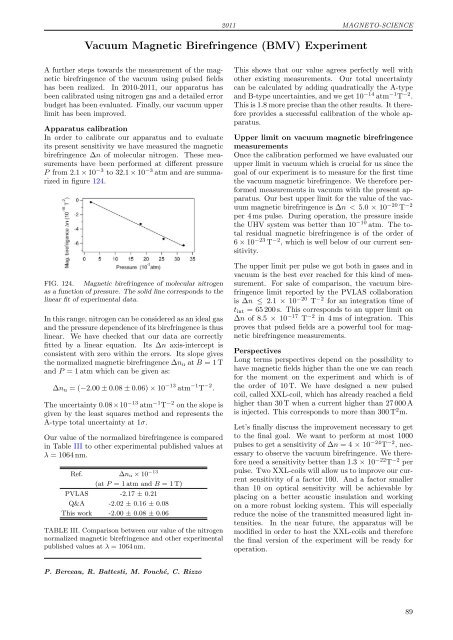2011 - Laboratoire National des Champs Magnétiques Intenses ...
2011 - Laboratoire National des Champs Magnétiques Intenses ...
2011 - Laboratoire National des Champs Magnétiques Intenses ...
You also want an ePaper? Increase the reach of your titles
YUMPU automatically turns print PDFs into web optimized ePapers that Google loves.
<strong>2011</strong> MAGNETO-SCIENCEVacuum Magnetic Birefringence (BMV) ExperimentA further steps towards the measurement of the magneticbirefringence of the vacuum using pulsed fieldshas been realized. In 2010-<strong>2011</strong>, our apparatus hasbeen calibrated using nitrogen gas and a detailed errorbudget has been evaluated. Finally, our vacuum upperlimit has been improved.Apparatus calibrationIn order to calibrate our apparatus and to evaluateits present sensitivity we have measured the magneticbirefringence ∆n of molecular nitrogen. These measurementshave been performed at different pressureP from 2.1 × 10 −3 to 32.1 × 10 −3 atm and are summarizedin figure 124.FIG. 124. Magnetic birefringence of molecular nitrogenas a function of pressure. The solid line corresponds to thelinear fit of experimental data.In this range, nitrogen can be considered as an ideal gasand the pressure dependence of its birefringence is thuslinear. We have checked that our data are correctlyfitted by a linear equation. Its ∆n axis-intercept isconsistent with zero within the errors. Its slope givesthe normalized magnetic birefringence ∆n u at B = 1 Tand P = 1 atm which can be given as:∆n u = (−2.00 ± 0.08 ± 0.06) × 10 −13 atm −1 T −2 .The uncertainty 0.08×10 −13 atm −1 T −2 on the slope isgiven by the least squares method and represents theA-type total uncertainty at 1σ.Our value of the normalized birefringence is comparedin Table III to other experimental published values atλ = 1064 nm.Ref.∆n u × 10 −13(at P = 1 atm and B = 1 T)PVLAS -2.17 ± 0.21Q&A -2.02 ± 0.16 ± 0.08This work -2.00 ± 0.08 ± 0.06TABLE III. Comparison between our value of the nitrogennormalized magnetic birefringence and other experimentalpublished values at λ = 1064 nm.This shows that our value agrees perfectly well withother existing measurements. Our total uncertaintycan be calculated by adding quadratically the A-typeand B-type uncertainties, and we get 10 −14 atm −1 T −2 .This is 1.8 more precise than the other results. It thereforeprovi<strong>des</strong> a successful calibration of the whole apparatus.Upper limit on vacuum magnetic birefringencemeasurementsOnce the calibration performed we have evaluated ourupper limit in vacuum which is crucial for us since thegoal of our experiment is to measure for the first timethe vacuum magnetic birefringence. We therefore performedmeasurements in vacuum with the present apparatus.Our best upper limit for the value of the vacuummagnetic birefringence is ∆n < 5.0 × 10 −20 T −2per 4 ms pulse. During operation, the pressure insidethe UHV system was better than 10 −10 atm. The totalresidual magnetic birefringence is of the order of6 × 10 −23 T −2 , which is well below of our current sensitivity.The upper limit per pulse we got both in gases and invacuum is the best ever reached for this kind of measurement.For sake of comparison, the vacuum birefringencelimit reported by the PVLAS collaborationis ∆n ≤ 2.1 × 10 −20 T −2 for an integration time oft int = 65 200 s. This corresponds to an upper limit on∆n of 8.5 × 10 −17 T −2 in 4 ms of integration. Thisproves that pulsed fields are a powerful tool for magneticbirefringence measurements.PerspectivesLong terms perspectives depend on the possibility tohave magnetic fields higher than the one we can reachfor the moment on the experiment and which is ofthe order of 10 T. We have <strong>des</strong>igned a new pulsedcoil, called XXL-coil, which has already reached a fieldhigher than 30 T when a current higher than 27 000 Ais injected. This corresponds to more than 300 T 2 m.Let’s finally discuss the improvement necessary to getto the final goal. We want to perform at most 1000pulses to get a sensitivity of ∆n = 4 × 10 −24 T −2 , necessaryto observe the vacuum birefringence. We thereforeneed a sensitivity better than 1.3 × 10 −22 T −2 perpulse. Two XXL-coils will allow us to improve our currentsensitivity of a factor 100. And a factor smallerthan 10 on optical sensitivity will be achievable byplacing on a better acoustic insulation and workingon a more robust locking system. This will especiallyreduce the noise of the transmitted measured light intensities.In the near future, the apparatus will bemodified in order to host the XXL-coils and thereforethe final version of the experiment will be ready foroperation.P. Berceau, R. Battesti, M. Fouché, C. Rizzo89


